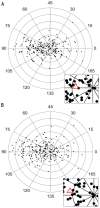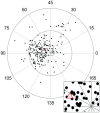Effect of the posterior corneal surface on total corneal astigmatism in patients with age-related cataract
- PMID: 29977807
- PMCID: PMC6010393
- DOI: 10.18240/ijo.2018.06.10
Effect of the posterior corneal surface on total corneal astigmatism in patients with age-related cataract
Abstract
Aim: To explore the effect of the posterior astigmatism on total corneal astigmatism and evaluate the error caused by substituting the corneal astigmatism of the simulated keratometriy (simulated K) for the total corneal astigmatism in age-related cataract patients.
Methods: A total of 211 eyes with age-related cataract from 164 patients (mean age: 66.8±9.0y, range: 45-83y) were examined using a multi-colored spot reflection topographer, and the total corneal astigmatism was measured. The power vector components J0 and J45 were analyzed. Correlations between the magnitude difference of the simulated K and total cornea astigmatism (magnitude differenceSimK-Tca), anterior J0, and absolute meridian difference (AMD) between the anterior and posterior astigmatisms were calculated. To compare the astigmatism of the simulated K and total cornea both in magnitude and axial orientation, we drew double-angle plots and calculated the vector difference between the two measures using vector analysis. A corrective regression formula was used to adjust the magnitude of the simulated K astigmatism to approach that of the total cornea.
Results: The magnitude differenceSimK-Tca was positively correlated with the anterior corneal J0 (Spearman's rho= 0.539; P<0.001) and negatively correlated with the AMDR (Spearman's rho=-0.875, P<0.001). When the anterior J0 value was larger than 1.3 D or smaller than -0.8 D, the errors caused by determining the total corneal astigmatism with the karatometric calculation tended to be greater than 0.25 D. An underestimation by 16% was observed for against the rule (ATR) astigmatism and an overestimation by 9% was observed for with the rule (WTR) astigmatism when ignoring the posterior measurements.
Conclusion: Posterior corneal astigmatism should be valued for more precise corneal astigmatism management, especially for higher ATR astigmatism of the anterior corneal surface. We suggest a 9% reduction in the magnitude of the simulated K in eyes with WTR astigmatism, and a 16% addition of the magnitude of the simulated K in eyes with ATR astigmatism.
Keywords: cataract; multi-colored spot reflection topographer; posterior corneal astigmatism; total corneal astigmatism.
Figures






Similar articles
-
The effect of posterior corneal flat meridian and astigmatism amount on the total corneal astigmatism estimated from anterior corneal measurements.Graefes Arch Clin Exp Ophthalmol. 2014 Nov;252(11):1769-77. doi: 10.1007/s00417-014-2737-9. Epub 2014 Jul 20. Graefes Arch Clin Exp Ophthalmol. 2014. PMID: 25038911
-
Comparison of surgically induced astigmatism between anterior and total cornea in 2.2 mm steep meridian incision cataract surgery.BMC Ophthalmol. 2021 Oct 19;21(1):373. doi: 10.1186/s12886-021-02131-x. BMC Ophthalmol. 2021. PMID: 34666720 Free PMC article.
-
[Distribution of the anterior corneal astigmatism in over 140 000 patients with age-related cataract].Zhonghua Yan Ke Za Zhi. 2021 Jan 11;57(1):56-62. doi: 10.3760/cma.j.cn112142-20200107-00010. Zhonghua Yan Ke Za Zhi. 2021. PMID: 33412643 Chinese.
-
Posterior Corneal Characteristics of Cataract Patients with High Myopia.PLoS One. 2016 Sep 7;11(9):e0162012. doi: 10.1371/journal.pone.0162012. eCollection 2016. PLoS One. 2016. PMID: 27603713 Free PMC article.
-
Distribution and internal correlations of corneal astigmatism in cataract patients.Sci Rep. 2021 Jun 1;11(1):11514. doi: 10.1038/s41598-021-91028-2. Sci Rep. 2021. PMID: 34075156 Free PMC article. Clinical Trial.
Cited by
-
Eyes of Aniso-Axial Length Individuals Share Generally Similar Corneal Biometrics with Normal Eyes in Cataract Population.J Ophthalmol. 2020 Oct 30;2020:4760978. doi: 10.1155/2020/4760978. eCollection 2020. J Ophthalmol. 2020. PMID: 33178451 Free PMC article.
-
The Impact of Changes in Corneal Back Surface Astigmatism on the Residual Astigmatic Refractive Error following Routine Uncomplicated Phacoemulsification.J Ophthalmol. 2020 Jul 22;2020:7395081. doi: 10.1155/2020/7395081. eCollection 2020. J Ophthalmol. 2020. PMID: 32774910 Free PMC article.
-
Distribution and related factors of corneal regularity and posterior corneal astigmatism in cataract patients.Clin Ophthalmol. 2019 Jul 24;13:1341-1352. doi: 10.2147/OPTH.S212946. eCollection 2019. Clin Ophthalmol. 2019. PMID: 31440022 Free PMC article.
-
Effects of steep-axis incision on corneal curvature in one-handed phacoemulsification.Int J Ophthalmol. 2019 Aug 18;12(8):1277-1282. doi: 10.18240/ijo.2019.08.07. eCollection 2019. Int J Ophthalmol. 2019. PMID: 31456917 Free PMC article.
-
The influence of routine uncomplicated phacoemulsification on the orthogonality of the cornea.Indian J Ophthalmol. 2021 May;69(5):1073-1079. doi: 10.4103/ijo.IJO_1168_20. Indian J Ophthalmol. 2021. PMID: 33913835 Free PMC article.
References
-
- Savini G, Næser K. An analysis of the factors influencing the residual refractive astigmatism after cataract surgery with toric intraocular lenses. Invest Ophthalmol Vis Sci. 2015;56(2):827–835. - PubMed
-
- Royston JM, Dunne MC, Barnes DA. Measurement of posterior corneal surface toricity. Optom Vis Sci. 1990;67(10):757–763. - PubMed
-
- Dunne MC, Royston JM, Barnes DA. Posterior corneal surface toricity and total corneal astigmatism. Optom Vis Sci. 1991;68(9):708–710. - PubMed
LinkOut - more resources
Full Text Sources
Other Literature Sources
Miscellaneous
